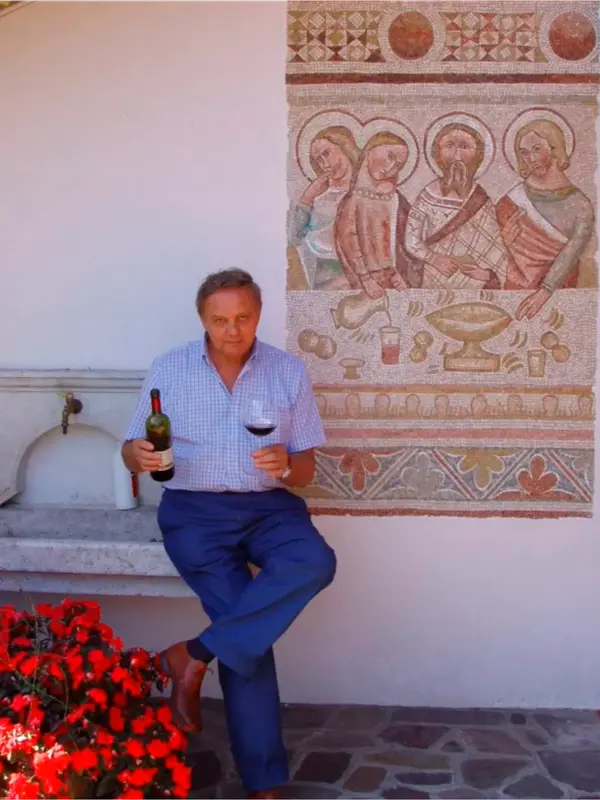
Emilio Bulfon
The first time we tasted the wines from Emilio Bulfon was at our first Prowein in Dusseldorf, we didn't know what to expect but the labels looked good. We tried it, really enjoyed it - they had a special nerve to them that was hard to explain, but the names of the wines and the grapes were quite different from anything we knew of and quickly forgot about the wines. The second time we saw the label(easy to recognize with the last supper label, from the local church fresco) was on our honeymoon in Venice, the sommelier/owner had put a bottle of Picolit-Neri on display alongside a bottle of Case Basse Soldera(that we bought) a wine that's truly an icon among wines, we recognized the fact that he, an Italian, put them side by side, this reinforced our acknowledgment. The second time we tasted the wines was again at Prowein, but we were late to the party and Lorenzo had left. Third time was the charm, the year after we tried the wines again and since they were, once again, magnificent we decided to believe in the interesting difference that the wines show with - the wines have their own style for all the grapes, something truly unique for Emilio Bulfon.
Emilio Bulfon’s winery is located in the piedmont territory of the Province of Pordenone, between the villages of Castelnovo del Friuli and Pinzano al Tagliamento. It stretches over a hilly land, made up of 15.90 hectares, 12 of them being cultivated exclusively for reclaimed autochthonous Friulan varietes.
These are ancient vines that seemed to be dismissed about thirty years ago, as engulfed by thorns and man’s negligence, although being in a land historically vocated to wine-growing. Only Emilio Bulfon’s devotion made them recover and bring them to a new life, paying so much respect and care as they were just archeological finds. Thus Emilio accomplished a great work of singling out, breeding and and re-planting operations, with the precious support of the scholar Antonio Calò, director of the Istituto Sperimentale of Conegliano, and Ruggero Forti, expert in ampelography.
Recovering ancient Friulan wine varieties, being cultivated for centuries in West Friuli, is the main purpose of Bulfon’s winery. The whole business project lies on the great vocation and devotion of Emilio Bulfon for these autochthonous varietes, as well as the great support coming from the wife Noemi, the daughter Alberta and the son Lorenzo, who is working the winery as well.
The unmistakable label, designed by Bulfon himself in so many chromatic versions as his wine varieties, reproduces a detail of “The Last Supper” from a medieval fresco dating back in the 13th century and being kept in the Santa Maria dei Battuti’s church in Valeriano village.
In the vineyard
- Organically grown grapes – no herbicides, no pesticides, natural compost and other organic fertilizer only.
- Native grasses planted between the rows to add to a self-sufficient ecosystem and inhibit erosion. With sheep to grass between the rows. (not every year.)
- De-budding and de-shooting by hand to ensure that each vine is focusing all of its energy on the selected shoots and grape bunches, limiting the number of bunches produced by each vine.
- Leaf-thinning by hand of each vine to allow each bunch greater exposure to sunlight and keeping the bunches ventilated thereby reducing disease.
- Bunch-thinning by hand where necessary to eliminate any bunches affected by sour rot or bunches ripening unevenly.
- Hand-picked grapes.
- low yields.
- SQNPI certified (Systainable certification - symbol with the bee.) The "Integrated Crop Management National Quality System"certifies that both vineyards and wines respect the environment and health through low environmental impact, integrated pest management, additional with traceability and sustainability guaranteed for all raw materials.
- Soft pruning of the wines - To reduce big wounds and stress for the vines.
In the Winery
- Use of naturally occurring yeasts only.
- Barrel-fermentation and aging
- Stirring the lees in the barrels several times each month by hand to encourage natural aromas and protect the juice from oxidation.
- No fining or cold-treatment of the wine.
- A very low dose of sulfite, 1 gram per hectoliter of wine.
- Minimal use of new oak barrels to avoid the classic “wood” tastes found so often in white wine which mask the true flavors and aromas of the grapes.
- The wooden barrels of 3 hectoliter and 25 hectoliter used are on average 10 years old.
- Storage of wine in Innovative 4-hectoliter ceramic barrels "Clayver ceramic wine barrels" these are made with a particular homogeneous and compact natural ceramic stoneware. This is a material that is similar in many ways to natural granite: it is impermeable by liquids and therefore does not require any precautions to avoid evaporation. The intrinsic microporous structure of the ceramic material allow gas exchange with the outside of the container but only in limited quantities and on very long slow. The container is therefore also suitable for long aging.
" For me the most important thing is to keep in the wine that I make the characteristics and typicality of the grape variety, with consistency and dedication.." – Lorenzo Bulfon
